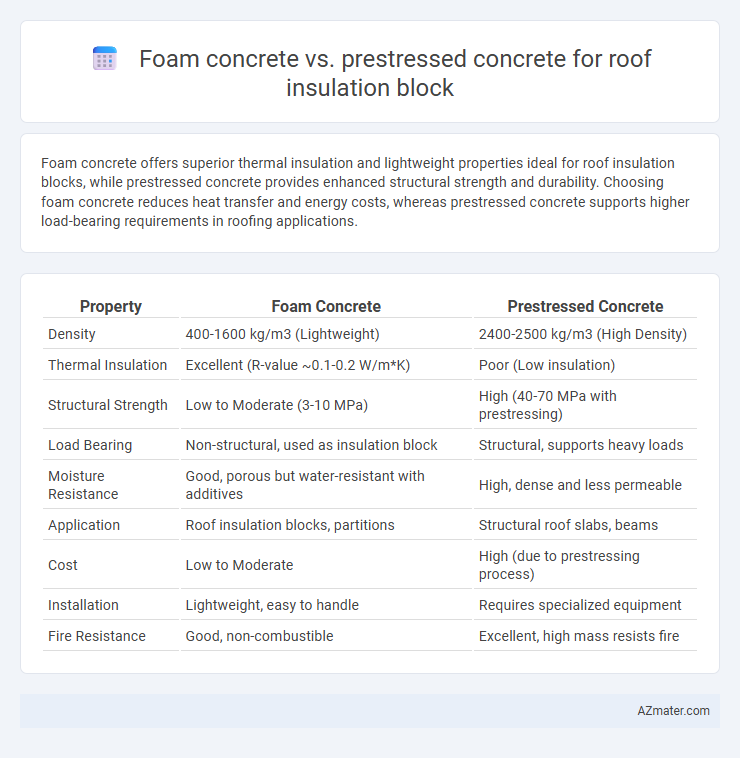Foam concrete offers superior thermal insulation and lightweight properties ideal for roof insulation blocks, while prestressed concrete provides enhanced structural strength and durability. Choosing foam concrete reduces heat transfer and energy costs, whereas prestressed concrete supports higher load-bearing requirements in roofing applications.
Table of Comparison
| Property | Foam Concrete | Prestressed Concrete |
|---|---|---|
| Density | 400-1600 kg/m3 (Lightweight) | 2400-2500 kg/m3 (High Density) |
| Thermal Insulation | Excellent (R-value ~0.1-0.2 W/m*K) | Poor (Low insulation) |
| Structural Strength | Low to Moderate (3-10 MPa) | High (40-70 MPa with prestressing) |
| Load Bearing | Non-structural, used as insulation block | Structural, supports heavy loads |
| Moisture Resistance | Good, porous but water-resistant with additives | High, dense and less permeable |
| Application | Roof insulation blocks, partitions | Structural roof slabs, beams |
| Cost | Low to Moderate | High (due to prestressing process) |
| Installation | Lightweight, easy to handle | Requires specialized equipment |
| Fire Resistance | Good, non-combustible | Excellent, high mass resists fire |
Overview: Foam Concrete and Prestressed Concrete for Roof Insulation
Foam concrete offers excellent thermal insulation, lightweight properties, and ease of installation for roof insulation blocks, making it ideal for energy-efficient buildings. Prestressed concrete provides superior structural strength and durability, allowing roof insulation blocks to withstand heavy loads and seismic forces while maintaining stability. Combining foam concrete's insulation efficiency with prestressed concrete's load-bearing capacity results in optimized roof insulation solutions for both thermal performance and structural integrity.
Material Composition and Properties Comparison
Foam concrete consists of cement, water, and a foaming agent that creates air bubbles, resulting in low density and excellent thermal insulation but lower compressive strength. Prestressed concrete incorporates high-strength steel tendons or cables tensioned before or after casting, providing superior structural strength and durability but with comparatively higher thermal conductivity. The lightweight and insulating properties of foam concrete make it ideal for roof insulation blocks, while prestressed concrete suits applications requiring high load-bearing capacity and reduced deflection.
Thermal Insulation Performance Analysis
Foam concrete exhibits superior thermal insulation performance due to its low density and high porosity, resulting in lower thermal conductivity values compared to prestressed concrete blocks. Prestressed concrete, while providing enhanced structural strength, typically has higher thermal conductivity, making it less efficient for roof insulation. Thermal performance tests indicate foam concrete blocks reduce heat transfer significantly, contributing to improved energy efficiency and indoor comfort in roofing applications.
Structural Strength and Load-Bearing Capabilities
Foam concrete offers excellent thermal insulation and lightweight properties but has lower structural strength and limited load-bearing capabilities compared to prestressed concrete. Prestressed concrete roof insulation blocks provide superior strength and durability by pre-compressing the material, allowing it to withstand higher loads and structural stresses. For applications requiring robust load-bearing capacity and enhanced structural integrity, prestressed concrete blocks are the optimal choice.
Installation Methods and Construction Time
Foam concrete roof insulation blocks offer lightweight handling and easier onsite cutting, allowing faster installation with simple mixing and pouring methods. Prestressed concrete blocks require specialized tensioning equipment and precasting processes, which extend construction time but provide higher strength and durability. Foam concrete's rapid curing time reduces overall project duration compared to the longer curing and prestressing stages of prestressed concrete blocks.
Durability and Lifespan Expectations
Foam concrete offers excellent thermal insulation and lightweight properties but generally has lower compressive strength and durability compared to prestressed concrete. Prestressed concrete blocks provide superior structural integrity and resistance to cracking, resulting in a longer lifespan and enhanced durability under load-bearing conditions. For roof insulation, prestressed concrete blocks are preferred when durability and longevity are critical, while foam concrete blocks are suitable for non-load-bearing insulation needs with moderate lifespan expectations.
Cost Comparison: Materials and Labor
Foam concrete offers lower material costs due to its lightweight composition and reduced cement content, making it an economical choice for roof insulation blocks. Labor expenses are generally decreased with foam concrete because of its ease of handling and faster installation compared to prestressed concrete, which requires specialized skills and additional equipment for tensioning steel tendons. Prestressed concrete, while more durable and structurally efficient, incurs higher overall costs driven by expensive materials such as high-strength steel and longer labor hours for precise tensioning and curing processes.
Environmental Impact and Sustainability
Foam concrete offers superior thermal insulation and lower embodied energy compared to prestressed concrete, significantly reducing greenhouse gas emissions during production. Its lightweight, porous structure enhances energy efficiency in roofing applications by minimizing heat transfer, contributing to sustainable building practices. Prestressed concrete, while structurally stronger, demands higher cement content and energy-intensive manufacturing processes, resulting in a larger environmental footprint than foam concrete insulation blocks.
Maintenance Requirements and Long-Term Performance
Foam concrete offers superior thermal insulation and lightweight properties, reducing roof load and minimizing thermal bridging, which can decrease maintenance frequency related to temperature-induced damage. Prestressed concrete provides higher structural strength and durability, enhancing long-term performance under heavy loads but may require regular inspections for tension losses or cracking. Both materials demand different maintenance approaches: foam concrete requires periodic checks for moisture infiltration and surface wear, while prestressed concrete benefits from monitoring tendon integrity and concrete surface condition to ensure longevity.
Best Applications and Suitability Recommendations
Foam concrete offers superior thermal insulation and lightweight properties, making it ideal for roof insulation blocks in residential and low-rise buildings where energy efficiency and ease of installation are priorities. Prestressed concrete, with its high strength and durability, suits commercial and industrial roofing systems requiring load-bearing capacity and resistance to heavy environmental stress. Choosing foam concrete is recommended for enhanced insulation and cost-effectiveness, while prestressed concrete is best for structural demands and longevity in large-scale roofing projects.

Infographic: Foam concrete vs Prestressed concrete for Roof insulation BLOCK
 azmater.com
azmater.com